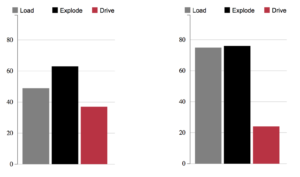
With every new partnership, one of the most common questions we get is “How often should we assess?” Our answer to this is always the same: “As often as you’re willing to do something about it.” Now this may seem like a simple it depends cop out, but there is really some beauty in the simplicity of this thought. Sport today is obsessed with MORE analytics and MORE data collection, but the truth is if we don’t understand this information and it doesn’t change anything, what is the value?
One of the easiest ways to understand how often testing should occur is to know what your data can tell you, and in turn how you can use it. Do you measure internal load, external load, performance metrics, skills, or athlete characteristics? Depending on the type of data you are collecting there will be different insights and interventions associated with it. For example, recording wellness data won’t tell you if an athlete is getting faster just as timing 40’s won’t tell you how an athlete is feeling; we must understand the information is different. Testing speed is often used to assess the effectiveness of a long term training program, while wellness is much more valuable in understanding short term how your athletes are feeling at a particular moment in time. Different types of data should have different goals associated with their collection.
Acuteinterventions such as adjustments to daily training and recovery protocols are going to require more frequent data collection. Wellness, GPS, HRV are good examples of types of data that are often collected daily and can (and should) drive some daily decision making. Athletes with extremely high or low running volume may need to adjust subsequent practices or training. Meanwhile, athletes with good recovery scores may be able to push harder in practice or training session than was originally planned.
More chronic interventions or longer term goals such as weight gain or loss may require less frequent data collection, but consistency will still be crucial to evaluate progress and adaptation. When I was a coach at the collegiate level utilizing bi-annual testing with my athletes, I was incredibly surprised by the number of my athletes that got worse based on this testing. After spending the last 12 weeks training the squat, how is it possible that an athlete’s squat max doesn’t go up, or in some cases even goes down? Measurable improvements in speed or strength don’t always occur linearly. In fact, in our experiences, they rarely occur along a straight line, when training these qualities the truth is they often get worse before they get better.

Sparta partners will often choose to assess at different times based on their goals or competitive calendar. During the competitive season, many organizations utilize the athlete’s Movement Signature data to monitor readiness or fatigue. They will assess their athletes weekly, looking for meaningful changes in their force profile that may identify at risk athletes. An athlete’s movement signature is a valid representation of their neuromuscular movement solution, but can also be used as a valid measure of internal load.
Everything affects an athlete’s movement just as everything affects an athlete’s performance. Sleep, stress (physical, mental, and emotional), soreness, and fatigue will all have some effect on an athlete… but to what extent? When utilizing an athlete’s Movement Signature to monitor fatigue, there are two main things we look for:
Extreme relationship changes
Changes resulting in greater imbalances
Athletes who are (1) utilizing different neuromuscular solutions to move can be at risk of injury just as (2) athletes with extreme imbalances can be. By identifying these meaningful changes, we are now able to intervene, immediately.

Identifying meaningful change can have huge implications for changes in protocol, but merely identifying significant change still has great value. During the offseason, our partners will often assess less frequently as they are more interested in longitudinal adaptations to training protocols. While significantly improving an athlete’s weakness may not seem as meaningful (their weakness will rarely become their strength) the fact that we can objectively measure and identify improvements consistently is extremely beneficial. Constantly assessing athletes will show acute changes, but over time we can see chronic adaptations take place.
Only testing your athletes once or twice a year, unfortunately, doesn’t always give us enough information to measure the efficacy of our program. An athlete may be considerably stronger, faster, more flexible, or more athletic, yet acute stressors can have significant effects that may lead us to believe otherwise. For example, most post-testing at the collegiate level occurs during times of high academic stress as it is simply the most practical time to do so. Weeks and months of training culminating in one day of poor performance will emotionally disappoint at best. Consistently assessing athletes every few weeks allows us to evaluate their adaptations over time as well as educate athletes on the peaks and valleys of their performance.
When it comes to data collection practicality is a must, while it may be fun to test your athletes when at their “freshest” or peak ability, the truth is this will rarely happen. Nothing operates in isolation; because the movement is affected both acutely and chronically, data collection should be frequent and consistent. Simply collecting data is often viewed as good enough, but the data we collect must represent value in our decision making to make its collection worthwhile.
Understand the type of data you are collecting as well as your goal for data collection.
Consistency is key. Monitoring acute changes requires more frequent data collection while evaluating chronic adaptations requires less frequency.
Data collection should drive interventions. If you aren’t using it why are you collecting it?